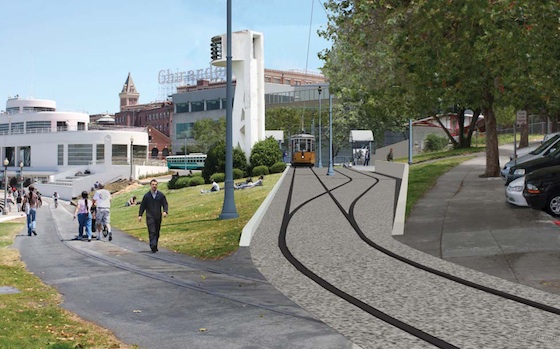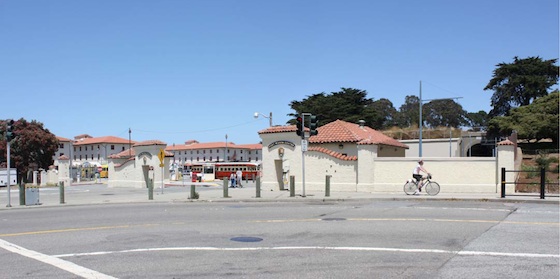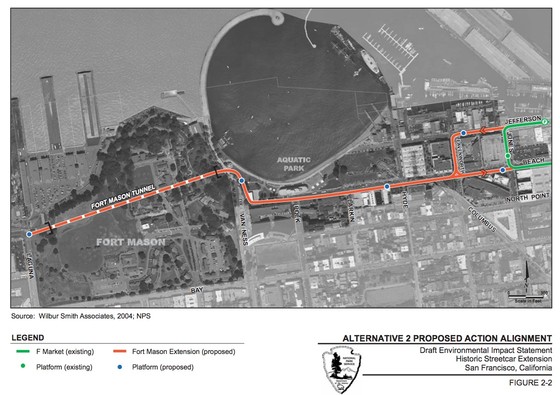Historic streetcar service to Aquatic Park and Fort Mason came a step closer today with the release of the Draft Environmental Impact Statement (DEIS) for the extension. The National Park Service was the lead agency on the DEIS because much of the 0.85 mile extension from Jones and Jefferson Streets to Fort Mason Center traverses federal parkland. However, the final design, construction, and operation of the extension would be done by Muni (part of the San Francisco Municipal Transportation Agency).
The DEIS, a lengthy document, can be downloaded and reviewed here. You can offer comments on the DEIS at the same site.
As the map above shows, the DEIS preferred alternative is an extension that extends the existing westbound F-line track one block to Leavenworth and uses that street to jog over to Beach, which would carry the extension on double track in both directions past the Hyde Street turntable, Ghirardelli Square, and the Maritime Museum to the end of Beach Street. From there, the double track would angle across the corner of Aquatic Park, as shown in the illustration below, to reach the historic 1914 railroad tunnel under Fort Mason, and use that single-track tunnel to reach a loop terminal east of Laguna Street, inside the Fort Mason boundaries.

The recommended terminal at Fort Mason would be a loop just outside the west tunnel portal in the Fort Mason Center parking lot, providing convenient service for the 1.8 million people who work or attend events at the facility annually. The photo simulation below shows the terminal would be barely visible from outside the Fort Mason Center gate, yet would be in easy walking distance for thousands of Marina residents.

The estimated cost of constructing this alternative, including rehabilitation of the 1100-foot long tunnel, is $28.9 million. Public comments on the DEIS will be open on the project website until May 17, after which a Final EIS will be prepared. A Record of Decision (ROD), the final step in the federal environmental process, would then be expected by the end of 2011. If the project is certified, detailed design and engineering could then proceed.
Market Street Railway has advocated this project for almost a decade. Our members will receive a far more extensive analysis of the project in the next issue of our member newsletter, Inside Track, which will be mailed next week.

Great idea!! Hope it gets built soon!! Like the extension idea over to Leavenworth and the terminals at Aquatic Park and Fort Mason. I hope the residents, of the Marina, accept it as an alternative to the #30 trolley bus to get Downtown.
The Chronicle’s article this morning says the extension will bring streetcar service “to the Marina,” leaving the impression among a whole lot of readers that the plan is to take it INTO the Marina District, which our post – and the DEIS – make clear isn’t true. If you read the Chronicle story, please consider posting a comment there to correct that.
Rick, thanks for the post. Muni Diaries will certainly pass this news along to our readers. As a somewhat frequent F-Market rider, I’m curious: Will there be enough working streetcars in the system to handle the longer route and higher ridership for the Fort Mason extension?
Yes!It is about time.
Jeff, thanks. Market Street Railway wouldn’t have advocated for this extension if we didn’t think it could be operated properly by Muni. To enable both this extension and the E-Embarcadero line, we strongly supported Muni it its efforts to restore more streetcars. By the end of this year, contracts to renovate 17 additional historic streetcars are scheduled to be completed, giving us enough operational vehicles for the extension, for an increase in overall F-line service, and start up of the E-line to boot.
One important note: for planning purposes, the DEIS treats the extension as part of the F-line, but the trackage could be operated as an extension of the E-line instead. It all depends on what actual ridership turns out to be. Either way, separating the northern terminals of the E and the F (one at Fort Mason, the other at the current Wharf terminal) will give Muni a good tool to adjust service along the waterfront. This is critical because, with or without America’s Cup (and I personally believe there will be more than one America’s Cup here), there’s going to be even more transit demand along The Embarcadero as attractions like Exploratorium move there.
I remember visiting Fort Mason back in the 80’s to get a “Save the Whales” poster for a friend at the Greenpeace headquarters. Looking around at all the military buildings now dedicated to peaceful purposes (including a music studio), I thought, “And they shall beat their swords into plowshares….”
Mayoral candidate Michela Alioto Pier threw a lot of roadblocks and threw around a lot of mis information about this project while on the Board….she did so because some of her donors live near fort mason and don’t like streetcars.
It’s true that Sup. Alioto-Pier asked some tough questions, based in my opinion on misinformation supplied to her by constituents. But once that story hit, she received a more balanced view of the extension from other constituents, and told me clearly a few months ago that she does NOT oppose an extension to Fort Mason. I take her at her word.
It’s really important that everyone understand that this DEIS is NOT about an extension along Marina Boulevard to the Presidio or anything else; it’s strictly Fort Mason for the western terminal. Sadly, there are a few people I have met who will do everything they can to deny employees of the 40+ non-profits housed at Fort Mason Center, plus all the visitors to the events there, the right to attractive public transit, just because they’re afraid of something that isn’t even on the agenda.
Maybe someday the F line will be extended again to go all the way to the Golden Gate Bridge. That would be very cool!
BTW: anybody know how many additional streetcars are needed per additional mile (2 mile round-trip) of track added to maintain the same headway?
I see on the aerial photo above that the proposed alignment does not use the existing state belt tracks that pass the maritime museum. Why is this, and do you think that decision needs to be reconsidered?
This is explained to our members in the forthcoming issue of Inside Track. It’s also discussed at length in the report itself, which is available through the links in the story. This alternative was actually eliminated more than four years ago after the technical feasibility study.
Opposition to this project is not about a dislike for street cars, nor did Piers-Alioto get a bum steer. I love the F-Line cars and ride them often and I am still opposed to the extension.
Despite Rick’s assertions to the contrary there is strong evidence that this is just the first step towards pushing the line to the Presidio. Just for starters:
1) During the fight over placing the Fisher Museum in the Presidio the Trust released a plan to do just that: run the line through the tunnel and up to the Presidio.
2) The just released draft EIS on the project, which I just finished reading, on page 16 of Chapter 1 states:
“SF Maritime NHP General Management Plan. The 1997 General Management Plan of the SF Maritime NHP includes proposals to improve accessibility to the park by supporting related transportation proposals outlined in the GGNRA GMP and Presidio Trust Management Plan. These proposals include “opening the railroad tunnel under Fort Mason as an access to the maritime park from the Marina District and Presidio and extending the F-line rail system from Fisherman’s Wharf west through Aquatic Park…” (NPS 1997).”
Note the three dot ellipsis denoting an incomplete sentence. If one reads the original document (p.18, NPS 1997) you find the rest of the sentence:
“To improve access the park would support related transportation proposals in the Golden Gate National Recreation Area General Management Plan and the Presidio General Management Plan Amendment. These include opening the railroad tunnel under Fort Mason as an access to the maritime park from the Marina District and Presidio and extending the F-line rail system from Fisherman’s Wharf west through Aquatic Park to the Presidio; and establishment of a system of water shuttles accessing park sites in San Francisco Bay.”
Funny how those final three words – “to the Presidio” – was somehow omitted from the draft statement. I’m sure it was just an oversight.
Further if one reads the SFMTA FY2008-FY2027 Draft Short Range Transit Plan (Chapter 5, p.18) you find the section titled, “Historic Streetcar Extension to Fort Mason and the Presidio.”
“. . . . Currently, the NPS, SFMTA and FTA are cooperating in the preparation of an Environmental Impact Statement (EIS), funded by the NPS, for an historic streetcar extension from Fisherman’s Wharf to Fort Mason Center. The EIS is currently planned for completion in late 2008 or early 2009. It is possible that a precursor to E-line operation could consist of the simple extension of F-line streetcars from their current terminal near Fisherman’s Wharf to Fort Mason. A potential, subsequent extension would further extend historic streetcar service to The Presidio, possibly serving Crissy Field Environmental Center, the Letterman office complex, as well as the Presidio Main Post.”
The draft report itself is none too subtle about plans pushing to the Presidio. Page 18, referencing the “San Francisco General Plan: Northeastern Waterfront Area Plan”:
Policy 7.3. Connect the recreation and open space facilities of the Northeastern Waterfront with those of the Golden Gate National Recreation Area.
Policy 31.3. . . . . Allow for continuous rail transit service along the length of the waterfront.
The idea is clear, push the thing to the Presidio. Once through to Ft. Mason the logic would be overwhelming, which is exactly what extension supporters are counting on.
The Draft EIS in my opinion is a rather disingenuous document with a number of dubious assertions and assumptions, which I’ll post on later.
Folks, we’re going to see variations on this theme throughout the public comment process from people who can’t take “yes” as an answer to the question, “Is the extension going to end at Fort Mason?” The answer to that question — again — is “yes.” But they don’t want you to hear that question. They’re determined to make this a crusade against an extension to the Presidio, which this project is not.
For all practical purposes, they’ve already won that battle against a Presidio extension (though some railfans might not like hearing that). But that’s not good enough for them. They’re determined to deny their neighbors better transit service for their own self-interested reasons.
See, it’s important to understand that most of the scattered opposition to the streetcar extension from Fort Mason comes from a handful of homeowners on Marina Boulevard. Their homes are worth a lot of money. It’s understandable that they don’t want streetcar tracks and wires on the street in front of their homes. Of course it’s their right to oppose that. Several of them did, quite vocally, five years ago when public comments were taken on the Technical Feasibility Study for a streetcar extension. The result: only the extension from the Wharf to Fort Mason went forward into an Environmental Impact Statement process. There has been no further study of an additional extension to the Presidio, and no interest from any involved agency in pursuing funding for such a study in the foreseeable future.
The documents the commenter cites that predate the decision not to go beyond Fort Mason in the DEIS are irrelevant. Did some planners once dream about taking streetcars farther, to the Presidio? Yes. Then it got studied, and tabled.
Planners have dreamed about a lot of things in San Francisco, most of which never happen; yet the commenter implies that the mere positing of a possibility equates to a fait accompli. Consider his quotation of a Muni planning document mentioning a “potential” extension “possibly” reaching points in the Presidio (planners know big-time caveats like that are code for “this ain’t gonna happen, folks.”) What he doesn’t include in his quotation is the next sentence from that Muni planning document: “This extension [to the Presidio] will need to be analyzed in detail, with full public participation and input, in a future environmental study.” In other words, you can’t just keep building to the Presidio. It requires an extensive public process involving one of the strongest NIMBY groups in the city. Leaving that important sentence out of his quotation is an odd omission for a commenter who had just finished excoriating the National Park Service for shortening a sentence in a document THEY quoted. But it’s consistent with the theme we’ve seen before: scare people into thinking that it’s not enough to keep streetcars off Marina Boulevard; they must also keep them from coming anywhere NEAR Marina Boulevard.
The problem with that tactic is that, if successful, it would deny the workers at the 40 non-profit organizations housed at Fort Mason attractive, affordable Muni service that would carry them directly between their workplace and regional transit connections, the Ferry Building, and Market Street. It would similarly deny that attractive service to the 1.8 million annual visitors to Fort Mason Center, who overwhelmingly drive automobiles to get there now. And with gasoline prices where they are, transit is a more important option than ever, especially to non-profit workers and people on fixed incomes.
The streetcar extension would also make Fort Mason far more accessible to disabled visitors. Right now, disabled Muni riders wanting to reach Fort Mason from the Financial District or the Ferry Building have to take two bus lines and are still dropped off four blocks or more from Fort Mason Center. And the extension terminal, east of Laguna Street in Fort Mason proper, would still be convenient for thousands of Marina residents within walking distance of it.
None of these benefits to other people seem to matter to this commenter, though.
Regarding the “F” extension crossing the Hyde St. cable car line: While looking through some earlier entries, I found a “What Might Have Been” article from back in 2008, with a photo of PCC 1006 on Van Ness about to cross the Washington-Jackson cable line. We know that in the old days, electric and cable lines crossed in several places, but this was “photographic evidence”.
Having the F line run into Ft. Mason would give a great alternative to the horrid 30 Muni service! And having the ability for people to easily get to Ft. Mason from Ferry/Bart/downtown & NOT have to drive should be an attractive solution to the Marina Blvd worryworts!
When I mentioned this to the people I know, there was nothing but support and excitement.
I’m totally excited about this project. Anything that San Francisco can do to expand rail service city wide is in the best interest all San Franciscans. This particular project has a lot of financial benefits as well from a tourism perspective and I really hope this gets done.